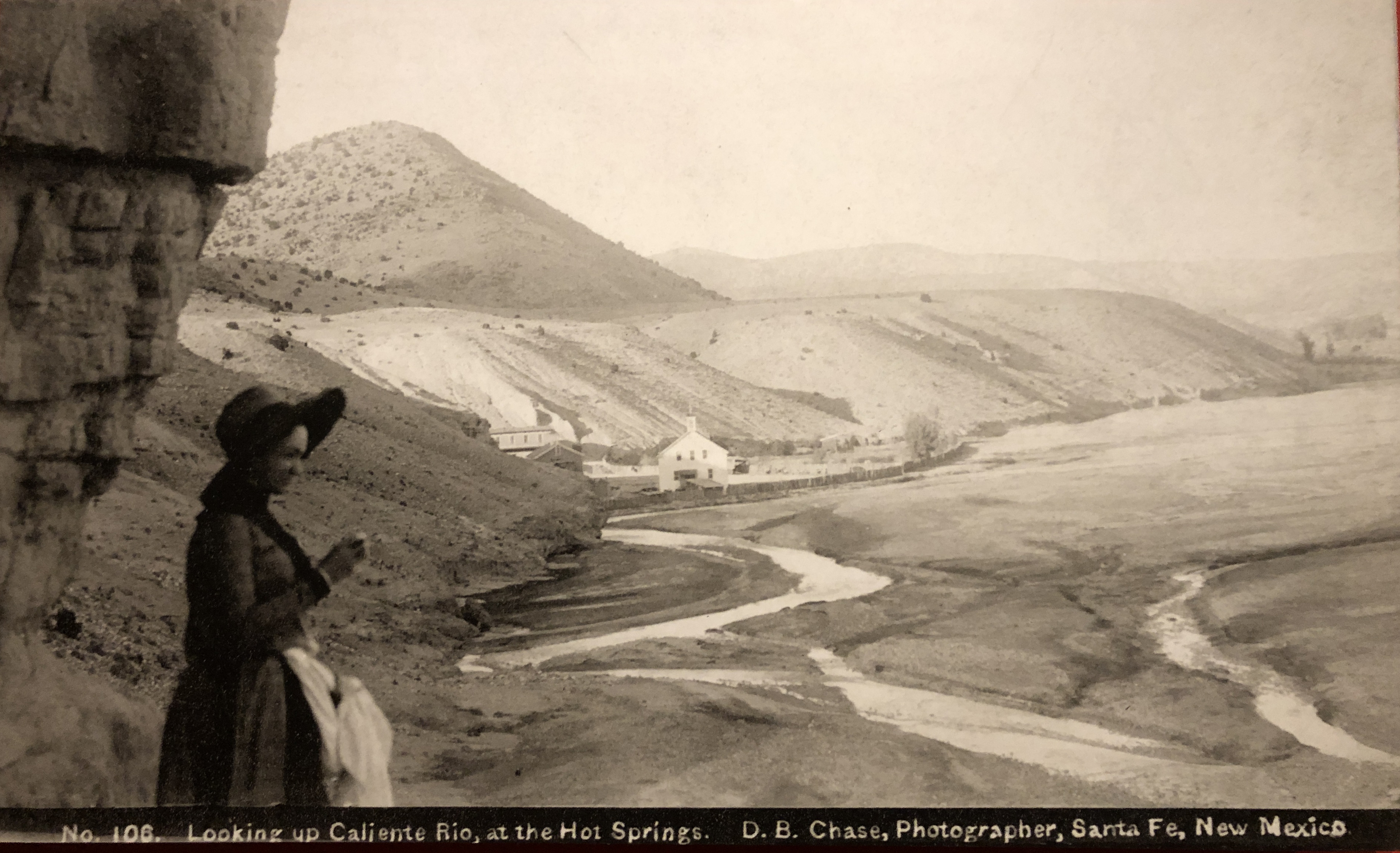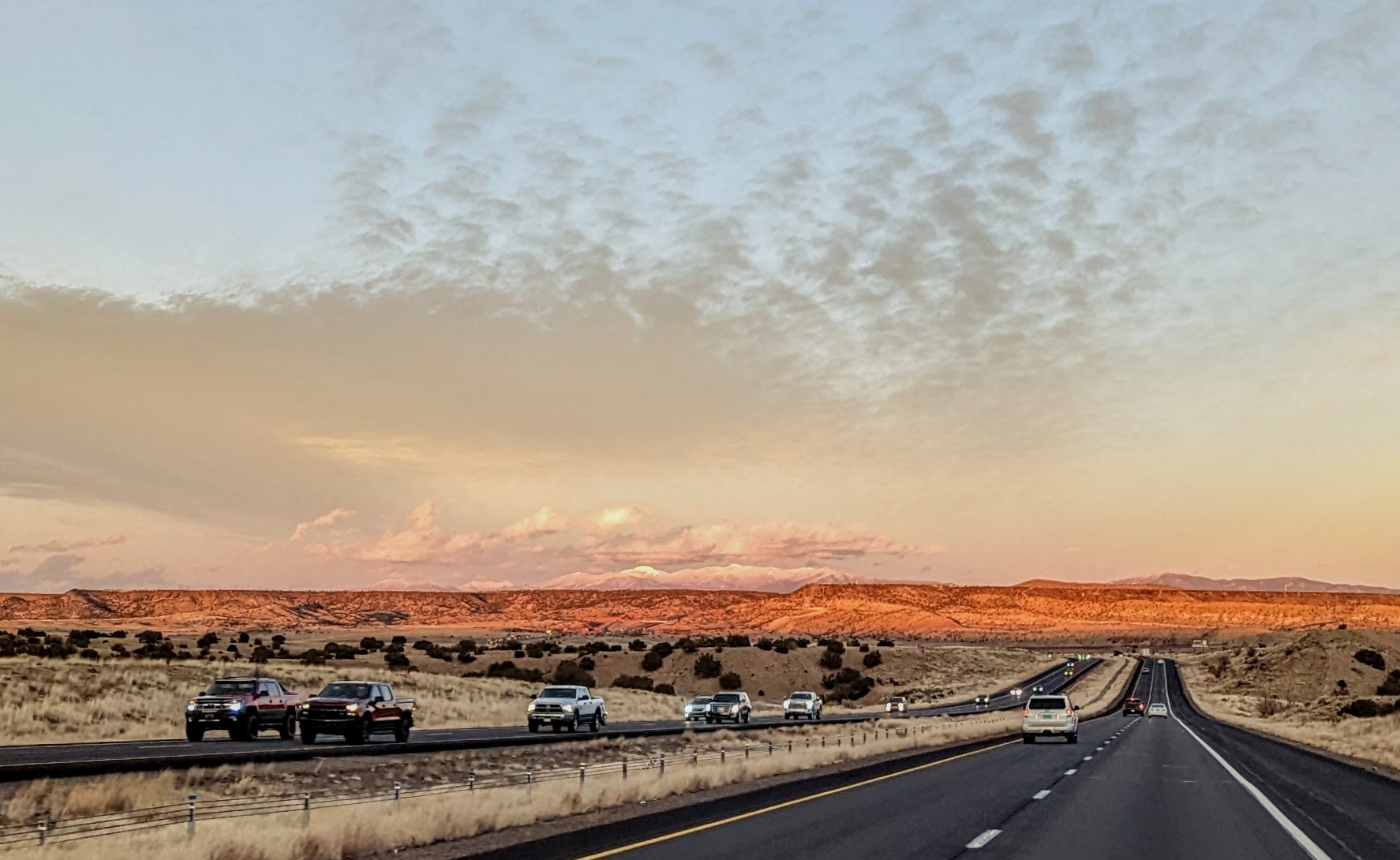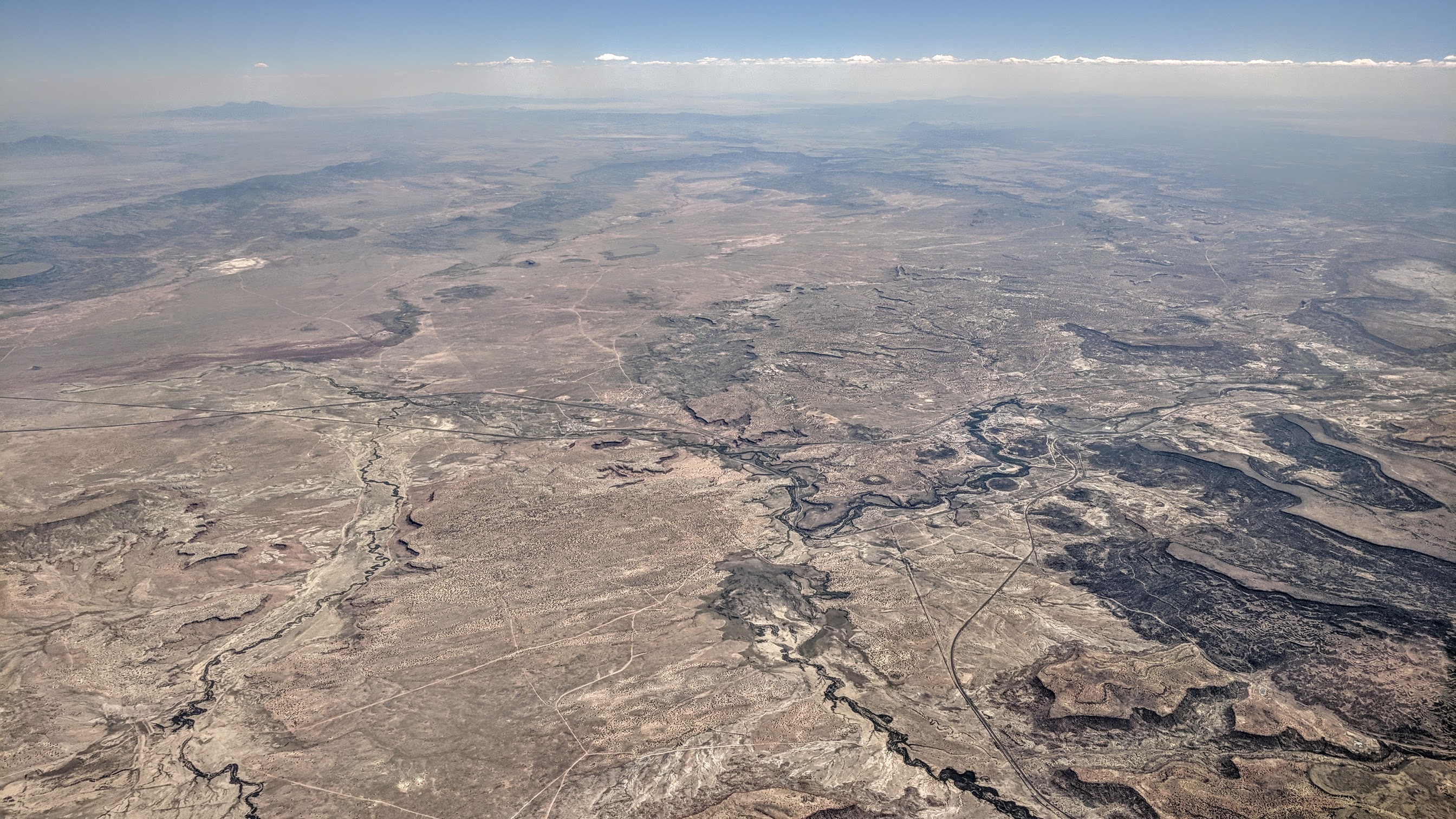|
U.S. Route 285
U.S. Route 285 is a north–south United States highway, running 846 miles (1,362 km) through the states of Texas, New Mexico and Colorado. The highway's southern terminus is in Sanderson, Texas at an intersection with U.S. Route 90. US 285 has always had an endpoint in Denver, Colorado, although the original US 285 went north from Denver (that segment is now a part of U.S. Route 287). Today the highway's northern terminus is in Denver, at exit 201 on Interstate 25. US 285 is a secondary route of US 85, which it crosses in metro Denver, and technically crosses again in Santa Fe, New Mexico (today its parent route is largely concurrent with Interstate 25 through New Mexico, and as a result US 85 is no longer signed in New Mexico). US 285 also intersects a sibling route, US 385, in Fort Stockton, Texas. Route description , - , TX , 170 , 274 , - , NM , 412 , 663 , - , CO , 264 , 425 , - , Total , 846 , 1362 Texas The southern terminus of US 285 is at U.S. 90 ... [...More Info...] [...Related Items...] OR: [Wikipedia] [Google] [Baidu] |
Sanderson, Texas
Sanderson is a census-designated place (CDP) in and the county seat of Terrell County, Texas, United States. The population was 664 at the 2020 census. Sanderson was created in 1882 as a part of neighboring Pecos County. It became the seat of Terrell County in 1905. History Sanderson was founded in 1882. It was a division point for the Southern Pacific Railroad, where refueling and crew changes on its main transcontinental route took place. Mohair and wool production on surrounding ranches formed a significant part of the economy. The community entered in an economic decline when the operations involving sheep and goats decreased. A devastating flood in June 1965 killed 26 people and washed away homes and businesses near the usually dry Sanderson Creek. Since then, many flood-control dams have been erected across the arroyos upstream from the town. An illustrated tour brochure guides visitors past 50 historic sites, including several notable buildings remaining from the town' ... [...More Info...] [...Related Items...] OR: [Wikipedia] [Google] [Baidu] |
US 85
U.S. Route 85 (US 85) is a north–south United States Highway that travels in the Mountain and Northern Plains states of the United States. The southern terminus of the highway is at the Mexican border in El Paso, Texas, connecting with Mexican Federal Highway 45. The northern terminus is at the Canadian border in Fortuna, North Dakota, where the route continues north as Saskatchewan Highway 35. The highway route is part of the CanAm Highway. Sections of US 85 are designated as the Theodore Roosevelt Expressway. Route description , - , TX , 21 , 34 , - , NM , 483 , 777 , - , CO , 310 , 499 , - , WY , 256 , 412 , - , SD , 154 , 248 , - , ND , 255 , 410 , - , Total , 1479 , 2380 The highway passes through Texas, New Mexico, Colorado, Wyoming, South Dakota, and North Dakota. From Las Cruces, New Mexico to Fountain, Colorado, US-85 shares its alignment with I-25 and is not signed. Texas US 85 in Texas begins at the Mexico–US border with US 62 and travels ... [...More Info...] [...Related Items...] OR: [Wikipedia] [Google] [Baidu] |
Ojo Caliente, New Mexico
Ojo Caliente is an Unincorporated area, unincorporated community in Taos County, New Mexico, Taos County, New Mexico, United States, along the Rio Ojo Caliente. Description Ojo Caliente lies along U.S. Route 285 in New Mexico, U.S. Route 285 near the Rio Grande between Española, New Mexico, Española and Taos, New Mexico, Taos, approximately north of Santa Fe, New Mexico, Santa Fe, the state capital. The community consist mainly of small farms irrigated by acequias fed by water from the Rio Ojo Caliente. The community, known for its Ojo Caliente Hot Springs, is one of the oldest health resorts in North America. Tewa tradition holds that its pools provided access to the underworld. Frank Mauro purchased the springs in 1932, and it remained a family business for three generations. The resort's buildings are on the National Register of Historic Places./ The nearby Ojo Caliente Hot Springs Round Barn, built in 1924, is also listed on the National Register. References ... [...More Info...] [...Related Items...] OR: [Wikipedia] [Google] [Baidu] |
Colorado Plateau
The Colorado Plateau is a physiographic and desert region of the Intermontane Plateaus, roughly centered on the Four Corners region of the Southwestern United States. This plateau covers an area of 336,700 km2 (130,000 mi2) within western Colorado, northwestern New Mexico, southern and eastern Utah, northern Arizona, and a tiny fraction in the extreme southeast of Nevada. About 90% of the area is drained by the Colorado River and its main tributaries: the Green, San Juan, and Little Colorado. Most of the remainder of the plateau is drained by the Rio Grande and its tributaries. The Colorado Plateau is largely made up of high desert, with scattered areas of forests. In the south-west corner of the Colorado Plateau, nicknamed High Country, lies the Grand Canyon of the Colorado River. Much of the Plateau's landscape is related to the Grand Canyon in both appearance and geologic history. The nickname "Red Rock Country" suggests the brightly colored rock left bare to t ... [...More Info...] [...Related Items...] OR: [Wikipedia] [Google] [Baidu] |
Carson National Forest
Carson National Forest is a United States National Forest, national forest in northern New Mexico, United States. It encompasses 6,070 square kilometers (1.5 million acres) and is administered by the United States Forest Service. The Forest Service's "mixed use" policy allows for its use for recreation, grazing, and resource extraction. Geography The forest is disjunct with four separate areas managed by six ranger districts. On the east side in the Sangre de Cristo Mountains are two districts that are separated by the Taos Pueblo, New Mexico, Taos Pueblo. The west side of the forest has three are conjoined districts in the San Juan Mountains, sandwiched between the Santa Fe National Forest, Santa Fe and Rio Grande National Forest, Rio Grande national forests, and another in the San Juan Basin. The forest is located mainly in Rio Arriba County, New Mexico, Rio Arriba (63.4% of acreage) and Taos County, New Mexico, Taos (34.65%) counties, but smaller areas extend eastward into we ... [...More Info...] [...Related Items...] OR: [Wikipedia] [Google] [Baidu] |
Chamita, New Mexico
Chamita is a census-designated place in Rio Arriba County, New Mexico, United States. Its population was 870 as of the 2010 census. New Mexico State Road 74 passes through the community. During its earlier years, the community was known as San Pedro De Chamita and served as the first county seat for Rio Arriba county. Geography According to the U.S. Census Bureau, the community has an area of ; of its area is land, and is water. Both the Rio Grande and the Rio Chama flow through the community. The two rivers converge south of the area. Demographics Education It is in Española Public Schools. The comprehensive public high school is Española Valley High School. See also * List of census-designated places in New Mexico New Mexico is a state located in the Western United States. New Mexico has several census-designated places (CDPs) which are unincorporated communities lacking elected municipal officers and boundaries with legal status. List of census-design ... R ... [...More Info...] [...Related Items...] OR: [Wikipedia] [Google] [Baidu] |
Española, New Mexico
Española is a city primarily in Rio Arriba County, New Mexico, United States. A portion of the central and eastern section of the city is in Santa Fe County. Founded as a railroad village some distance from the old Indian town of San Juan de los Caballeros (now renamed Ohkay Owingeh), it was named Española and officially incorporated in 1925. It has been called the first capital city in the United States. As of the 2020 census, the population was at 10,526. Española is within the Albuquerque–Santa Fe–Los Alamos combined statistical area. The city is home to Northern New Mexico College. History Etymology Española was referred to as ''La Vega de los Vigiles'' ('the Vigils' Meadow') before the presence of railroads. ''La Española'' means 'Spanish woman', and folk history attributes the name to railroad construction workers who named the area after a woman who worked in a small restaurant in the area. In fact the name is a shortened form of ''Plaza Española'' ('Spanis ... [...More Info...] [...Related Items...] OR: [Wikipedia] [Google] [Baidu] |
Sangre De Cristo Mountains
The Sangre de Cristo Mountains (Spanish language, Spanish for "Blood of Christ") are the southernmost mountain range, subrange of the Rocky Mountains. They are located in southern Colorado and northern New Mexico in the United States. The mountains run from Poncha Pass in South-Central Colorado, trending southeast and south, ending at Glorieta Pass, southeast of Santa Fe, New Mexico. The mountains contain a number of fourteeners, fourteen thousand foot peaks in the Colorado portion, as well as several peaks in New Mexico which are over thirteen thousand feet. The name of the mountains may refer to the occasional reddish hues observed during sunrise and sunset, and when alpenglow occurs, especially when the mountains are covered with snow. Although the particular origin of the name is unclear, it has been in use since the early 19th century. Before that time the terms "La Sierra Nevada", "La Sierra Madre", "La Sierra", and "The Snowies" (used by English speakers) were used. Accordi ... [...More Info...] [...Related Items...] OR: [Wikipedia] [Google] [Baidu] |
I-25 (NM)
Interstate 25 (I-25) in the US state of New Mexico follows the north–south corridor through Albuquerque, New Mexico, Albuquerque and Santa Fe, New Mexico, Santa Fe. It replaced U.S. Route 85 (US 85), which is no longer signed, but still exists in route logs sharing most of the I-25 alignment. I-25 starts in New Mexico at an interchange with Interstate 10 in New Mexico, I-10 in Las Cruces, New Mexico, Las Cruces and extends roughly before reaching Colorado. I-25 passes through principally rural land through central New Mexico and passes through or near the cities of Las Cruces, New Mexico, Las Cruces, Truth or Consequences, New Mexico, Truth or Consequences, Socorro, New Mexico, Socorro, Belen, New Mexico, Belen, Albuquerque, New Mexico, Albuquerque, Santa Fe, New Mexico, Santa Fe, Las Vegas, New Mexico, Las Vegas, and Raton, New Mexico, Raton. Route description I-25 begins at Interstate 10 in New Mexico, I-10's exit 144 in Las Cruces (elevation ), just sou ... [...More Info...] [...Related Items...] OR: [Wikipedia] [Google] [Baidu] |
Clines Corners, NM
{{surname ...
Clines is a surname. Notable people with the surname include: * Gene Clines (1946–2022), American baseball player and coach * Hoyt Franklin Clines (1956–1994), American murderer * Mike Clines (fl 2022), American politician *Peter Clines (born 1969), American author and novelist * Thomas G. Clines (1928–2013), American spy See also *Cline (other) Cline may refer to: Science * Cline (biology), a measurable gradient in a single trait in a species across its geographical range * Cline (hydrology), a fluid layer with a property that varies * Cline (mathematics) or generalised circle, a circ ... [...More Info...] [...Related Items...] OR: [Wikipedia] [Google] [Baidu] |
Interstate 40 (New Mexico)
Interstate 40 (I-40), a major east–west route of the Interstate Highway System, runs east–west through Albuquerque in the US state of New Mexico. It is the direct replacement for the historic U.S. Highway 66 (US 66). Route description Arizona to Albuquerque As I-40 enters New Mexico in a northeasterly direction, it begins following the basin of the intermittent Puerco River ( Rio Puerco of the West, as opposed to the Rio Puerco of the East that it crosses near Albuquerque), roughly tracing the southern edge of the contiguous part of the Navajo Reservation in the state. The freeway enters Gallup later, paralleling the Burlington Northern Santa Fe Railway's southern transcontinental mainline. Leaving Gallup, the now more easterly I-40 passes to the north of Fort Wingate and part of the fragmented Cibola National Forest before crossing the North American continental divide via Campbell Pass at an elevation of , with the stratovolcano Mount Taylor t ... [...More Info...] [...Related Items...] OR: [Wikipedia] [Google] [Baidu] |
Interstate 20 In Texas
Interstate 20 in Texas (I-20) is a major east–west Interstate Highway in the Southern United States, running east from a junction with I-10 east of Kent, Texas, through the Dallas–Fort Worth metroplex to the Louisiana state line near Waskom, Texas. The original distance of I-20 was from I-10 to the Louisiana state line, reduced to the current distance of with the rerouting of I-20 in the 1980s and 1990s. I-20 is known as the Ronald Reagan Memorial Highway within the Dallas–Fort Worth metroplex. History I-20 in Texas was designated in 1959, and was to replace or run parallel to U.S. Route 80 (US 80). Initial construction began from east to west and as bypass loops around larger cities. By 1967, the highway was complete from the Louisiana state line to the western side of Fort Worth on a route to the south of US 80, with slower construction in the lesser populated areas of West Texas concurrent with US 80. On December 2, 1971, I-20 was rerou ... [...More Info...] [...Related Items...] OR: [Wikipedia] [Google] [Baidu] |







